Zion National Park
Saturday, 1st May
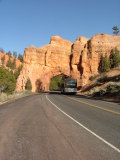
We drove down to Zion National Park, coming through the Eastern entrance.
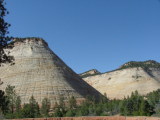
We stopped just before the long tunnel and walked up to the Overlook. We all made it along the trail with sheer drops on the side - Jo thinks the trail and the railing had improved since we were there in
October. The view down into the Canyon is magnificent! We then drove through the tunnel, stopping to take photos at different spots, to the Visitor's Center - being Saturday, the carpark was full and so we drove into the town of Springdale, immediately outside the National Park and parked, ate lunch, and caught the shuttle back to the park.
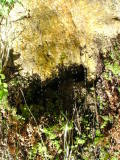
We took the park shuttle to the far end of Zion Canyon.
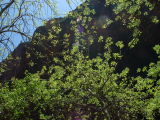
Along the way we saw a number of rock climbers scaling the sides of the Canyon. Zion Canyon is formed of a red stone and has sheer sides and a river running through the centre. We walked along the river to where the river runs through the Canyon with no flat ground either side - at this point the river becomes the trail and going further involves getting wet. We took the shuttle to another trail and walked to the weeping rock where water ran off a shelf above where we stood - it was a wall of drips rather than a continuous stream. It was quite refreshing given it was in the high 20s C. The final stop for the day was at the Zion Lodge, a hotel in the middle of the Canyon - it looked like a great place to stay.
From there we walked a mile or so the the Emerald Pools. The Emerald Pools, called that because they are meant to be the colour of emeralds, were a little disappointing. However, there were lower, middle and upper pools and between the lower and middle there was a tall cliff over which the water flowed between the pools - we walked behind the waterfall and up a steep track to get to the middle pools.
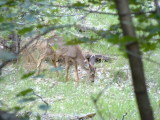
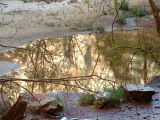
All the while we heard what sounded like a cross between a sheep bleating and a kookaburra with a megaphone - an NPS Ranger said it was a Canyon Tree Frog, and that it made a very loud noise for its size. The middle pools were quite shallow and still and made great reflections of the mountains with the afternoon sun on them. Whilst taking photos we heard some people talking about the frog and then realised that they were looking for it. We soon saw one, and can attest to their small size for such a loud noise. We then returned to the floor of the Canyon, and the shuttle bus, via the upper trail. Before the trail started heading downhill, we spotted Rob's parents who had returned along the lower trail - they were waiting on a bench at the bottom of the trail, and caught their attention.
That evening we stayed at a very new Quality Inn but we would have been lost if not for Jo's itinerary
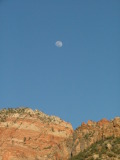
- for some reason the web site we booked through had put some other motel name, but the correct address. We were impressed by the hotel's zero tolerance policy for smoking: ie all rooms and buildings were non-smoking!
We went to a Pizza restaurant in what was an old church for dinner and ate pasta, stromboli, and calzone. The restaurant shared the building with an art gallery and we were able to view some beautiful photographs from our table.
Sunday 2nd May
The first guided walk for the season was that morning in Zion National Park, so we headed out first thing and were taken on a couple of hour guided walk by Ranger Brown. He was a budding naturalist and took time to stop and tell us about the plants we passed along the trail. We passed cottonwood, which was doing what it was named for - dropping white fluffy cotton-like stuff everywhere. Cottonwood, a large leafy tree, only grows where there is water; Zion National Park is in the desert, and so the only source of water is the river and small streams from underground water. Since Zion National Park was developed (and a dam installed upstream), the river has no longer changed path with the heavy rain and so the cottonwoods no longer are spread out across the Canyon floor amongst the meanderings of the river. We also saw Yukka, a cactus which has long stringy leaves which native Americans used for making string, binding things up with, etc - it is very strong if properly extracted from the plant. As the trail increased in elevation, off the canyon floor, we saw many different wild flowers which we now know the names of (thanks to the voice recorder on the camera). We passed pines that looked like they were dying - the Ranger said that in times of drought the tree shuts off one section at a time to conserve water and so a bit will die off - it tries to guarantee the plant's survival through drought. We also saw a plant known as Mormon or Indian Tea. It is a plant of lots of long stems. The centre of the stem is copper coloured. The Indians used to make a drink from it, hence Indian Tea. The tea contains small amounts of the stimulant ephedra, and some Mormons would drink it instead of coffee or tea, given that they weren't allowed to consume caffeine.
The walk took us up to a ridge from where we looked back down into the canyon, and also across to the other side.
Our guide described the various rock types and how some were permeable and some not. The water seeps down through the permeable layer, and hits and impermeable layer and appears from the walls of the canyon. The layers seen in Zion Canyon are similar to those seen in parts of the Grand Canyon.
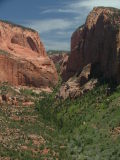
After returning to the carpark we drove out of the park and north on the first freeway or interstate we'd
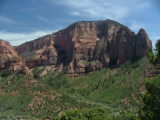
been on for nearly a week, to the less visited part of the park called Kolob Canyons. There we were amazed again by the magnificent scenery whilst we ate lunch. The colour of the rock was as red and different again to the other parts of Zion National Park. Given we wanted to be in Las Vegas with some afternoon remaining, we hopped back on the freeway and drove at >130km/h to Las Vegas. The road passed through some amazing mountains where it appeared that the side of the mountain had been swept into the valley to allow the road to pass.


 We drove down to Zion National Park, coming through the Eastern entrance.
We drove down to Zion National Park, coming through the Eastern entrance.  We stopped just before the long tunnel and walked up to the Overlook. We all made it along the trail with sheer drops on the side - Jo thinks the trail and the railing had improved since we were there in October. The view down into the Canyon is magnificent! We then drove through the tunnel, stopping to take photos at different spots, to the Visitor's Center - being Saturday, the carpark was full and so we drove into the town of Springdale, immediately outside the National Park and parked, ate lunch, and caught the shuttle back to the park.
We stopped just before the long tunnel and walked up to the Overlook. We all made it along the trail with sheer drops on the side - Jo thinks the trail and the railing had improved since we were there in October. The view down into the Canyon is magnificent! We then drove through the tunnel, stopping to take photos at different spots, to the Visitor's Center - being Saturday, the carpark was full and so we drove into the town of Springdale, immediately outside the National Park and parked, ate lunch, and caught the shuttle back to the park. We took the park shuttle to the far end of Zion Canyon.
We took the park shuttle to the far end of Zion Canyon.  Along the way we saw a number of rock climbers scaling the sides of the Canyon. Zion Canyon is formed of a red stone and has sheer sides and a river running through the centre. We walked along the river to where the river runs through the Canyon with no flat ground either side - at this point the river becomes the trail and going further involves getting wet. We took the shuttle to another trail and walked to the weeping rock where water ran off a shelf above where we stood - it was a wall of drips rather than a continuous stream. It was quite refreshing given it was in the high 20s C. The final stop for the day was at the Zion Lodge, a hotel in the middle of the Canyon - it looked like a great place to stay.
Along the way we saw a number of rock climbers scaling the sides of the Canyon. Zion Canyon is formed of a red stone and has sheer sides and a river running through the centre. We walked along the river to where the river runs through the Canyon with no flat ground either side - at this point the river becomes the trail and going further involves getting wet. We took the shuttle to another trail and walked to the weeping rock where water ran off a shelf above where we stood - it was a wall of drips rather than a continuous stream. It was quite refreshing given it was in the high 20s C. The final stop for the day was at the Zion Lodge, a hotel in the middle of the Canyon - it looked like a great place to stay.
 All the while we heard what sounded like a cross between a sheep bleating and a kookaburra with a megaphone - an NPS Ranger said it was a Canyon Tree Frog, and that it made a very loud noise for its size. The middle pools were quite shallow and still and made great reflections of the mountains with the afternoon sun on them. Whilst taking photos we heard some people talking about the frog and then realised that they were looking for it. We soon saw one, and can attest to their small size for such a loud noise. We then returned to the floor of the Canyon, and the shuttle bus, via the upper trail. Before the trail started heading downhill, we spotted Rob's parents who had returned along the lower trail - they were waiting on a bench at the bottom of the trail, and caught their attention.
All the while we heard what sounded like a cross between a sheep bleating and a kookaburra with a megaphone - an NPS Ranger said it was a Canyon Tree Frog, and that it made a very loud noise for its size. The middle pools were quite shallow and still and made great reflections of the mountains with the afternoon sun on them. Whilst taking photos we heard some people talking about the frog and then realised that they were looking for it. We soon saw one, and can attest to their small size for such a loud noise. We then returned to the floor of the Canyon, and the shuttle bus, via the upper trail. Before the trail started heading downhill, we spotted Rob's parents who had returned along the lower trail - they were waiting on a bench at the bottom of the trail, and caught their attention. - for some reason the web site we booked through had put some other motel name, but the correct address. We were impressed by the hotel's zero tolerance policy for smoking: ie all rooms and buildings were non-smoking!
- for some reason the web site we booked through had put some other motel name, but the correct address. We were impressed by the hotel's zero tolerance policy for smoking: ie all rooms and buildings were non-smoking! After returning to the carpark we drove out of the park and north on the first freeway or interstate we'd
After returning to the carpark we drove out of the park and north on the first freeway or interstate we'd  been on for nearly a week, to the less visited part of the park called Kolob Canyons. There we were amazed again by the magnificent scenery whilst we ate lunch. The colour of the rock was as red and different again to the other parts of Zion National Park. Given we wanted to be in Las Vegas with some afternoon remaining, we hopped back on the freeway and drove at >130km/h to Las Vegas. The road passed through some amazing mountains where it appeared that the side of the mountain had been swept into the valley to allow the road to pass.
been on for nearly a week, to the less visited part of the park called Kolob Canyons. There we were amazed again by the magnificent scenery whilst we ate lunch. The colour of the rock was as red and different again to the other parts of Zion National Park. Given we wanted to be in Las Vegas with some afternoon remaining, we hopped back on the freeway and drove at >130km/h to Las Vegas. The road passed through some amazing mountains where it appeared that the side of the mountain had been swept into the valley to allow the road to pass.